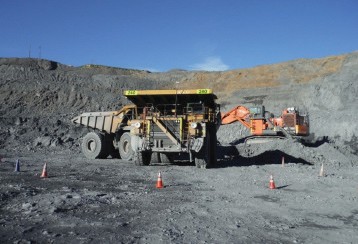Incident one
The excavator was pulling a hanging wall removing the waste off the top of the ore. During loading the excavator operator made a two-way call asking dump truck one (see figure 1) to move over to the right to finish loading. This required dump truck one to move out and then reverse back into a new position.
Dump truck two was queuing and its driver thought the first truck was leaving the loading zone and proceeded to drive into it. The two trucks then collided. No one was hurt but substantial damage occurred to the trucks.

Incident two
Dump truck one positioned itself in front of the excavator preparing to spot under the bucket (see figure 2). The excavator operator had to relocate to the opposite end of the bench for loading. The excavator driver then presented the bucket and the driver of the first truck had to manoeuvre whilst reversing further to the right to get under the bucket.
At the same time, dump truck two entered the work area without recognising that the excavator had relocated and that where it was now positioned was directly in the path of the reversing dump truck one (inside the mine operators 50 m exclusion zone around mobile plant). The right rear corner of dump truck hit the second truck.
Comment
There are similarities in both incidents which could have had potential fatal consequences. These incidents show the importance of:
- truck operators making a proper assessment of what is happening in the loading area
- communicating between dump truck, excavator and ancillary equipment operators
- having appropriate controls, including job rotation, adequate bench widths, strict compliance of exclusion zones to ensure safety when a routine task changes.
Excavator operators always need to communicate intentions via the two-way radio system. Dump truck operators need to be listening and remain alert to recognise changing conditions.








